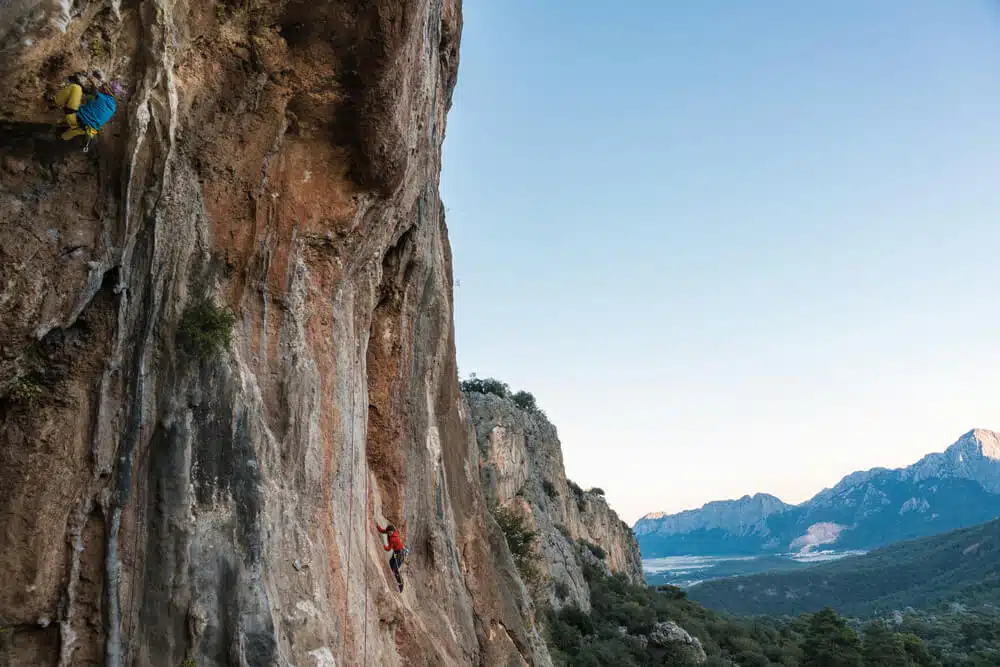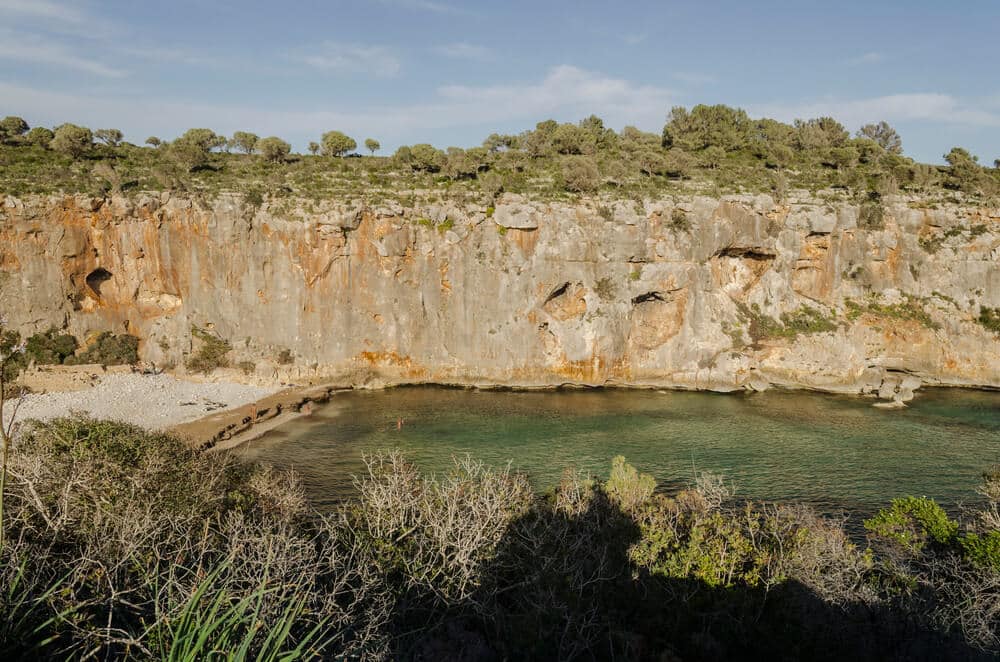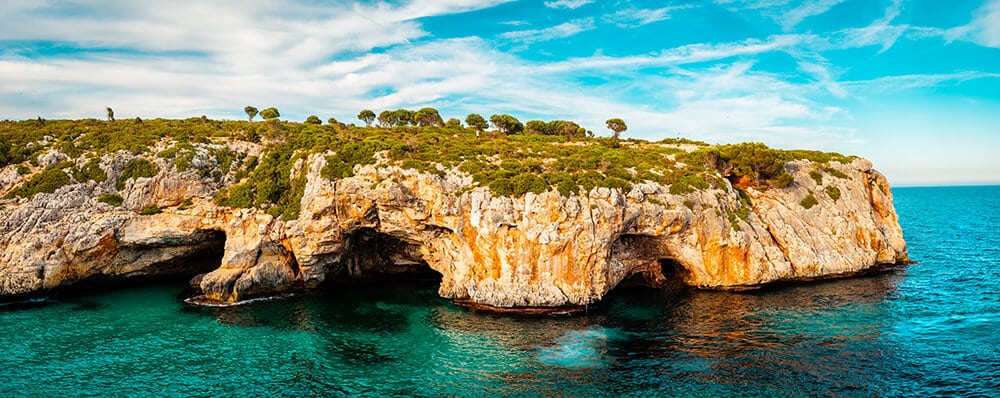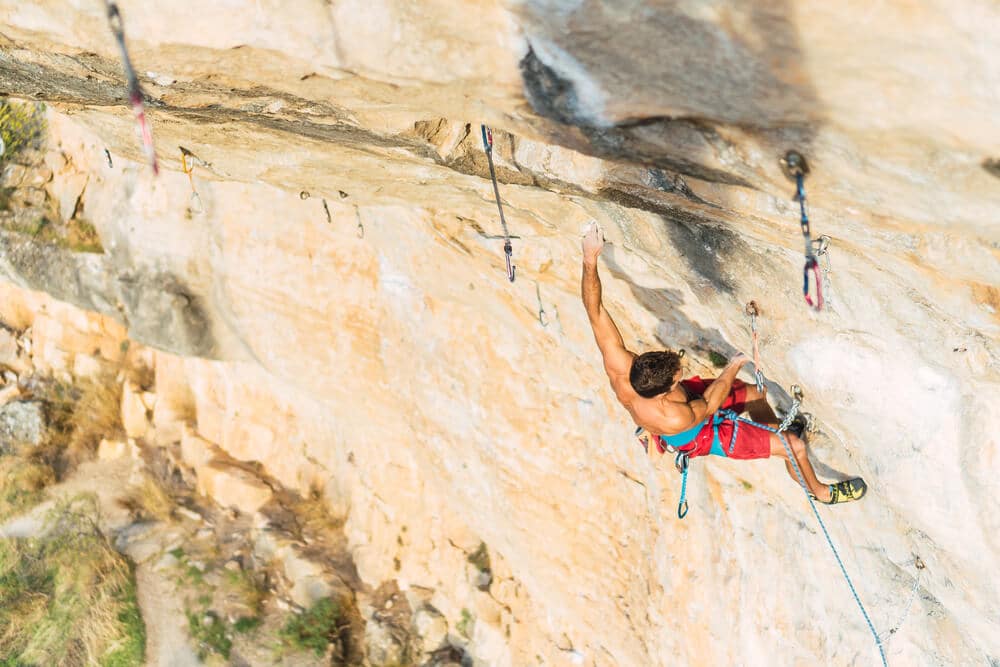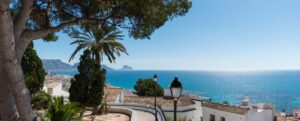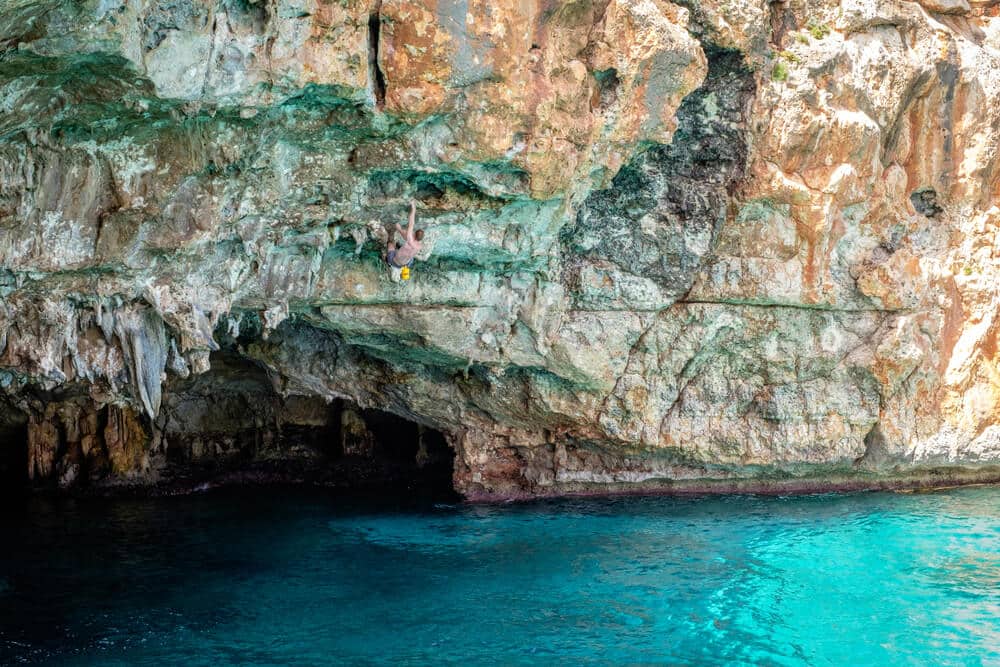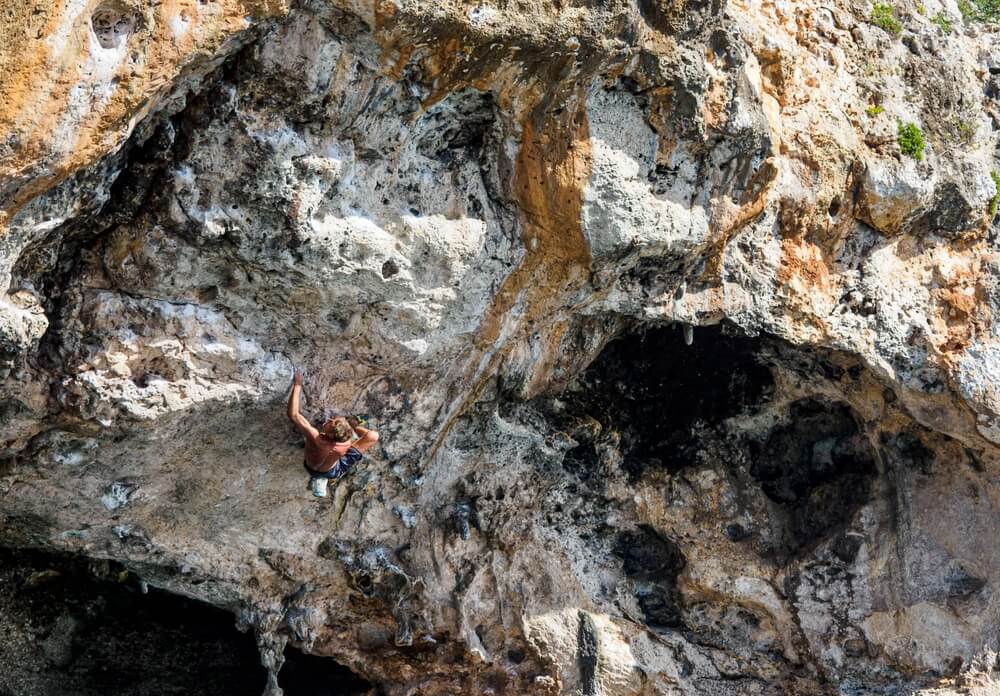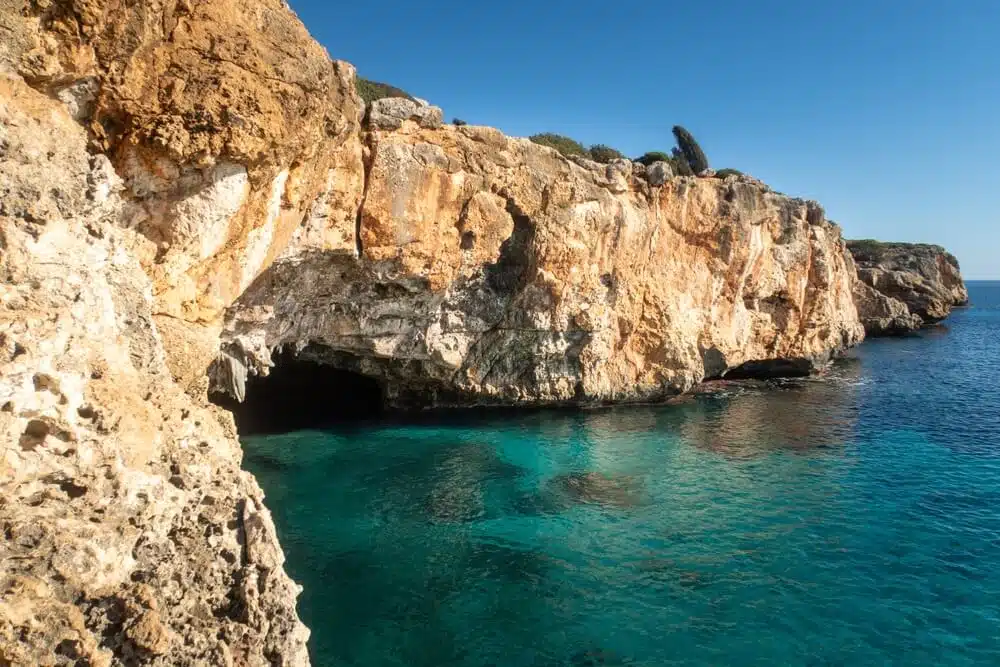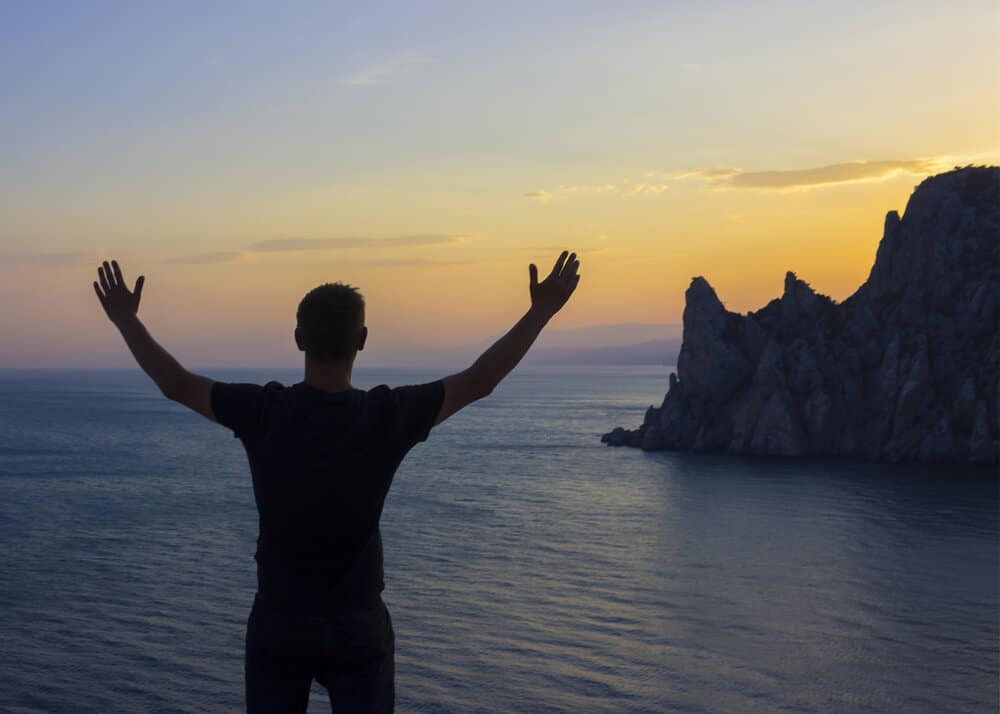Stellar limestone walls arrayed around a sun-drenched Mediterranean island off the coast of Spain… What’s not to like?
Mallorca is one of those climbing destinations you simply can’t miss. It’s among the best sport climbing locales in Europe, but it’s also a mecca for deep water soloing (psicobloc).
In this article, we’ll offer a basic guide to climbing on the famed island of Mallorca, then talk about specific tips for sport climbing and deep water soloing here.
Guide to Mallorca: Must-See Crags and Must-Do Routes
Sa Gubia
Near the town of Bunyola, Sa Gubia is among Mallorca’s largest climbing areas, boasting over 150 routes with grades ranging from 5a up to 8a.
Expect long routes and pumpy overhangs. It’s particularly famous for multi-pitches.
Among its many routes, Sal de Arenal (6c) and Albahida (5b) are quite popular, providing stunning views of the Serra de Tramuntana, a testament to the area’s natural beauty.
Fraguel
Close to Port de Soller, Fraguel houses over 60 routes, including the only 9a+ on the entire island, Big Men, sent by Iker Pou in 2015. Other classics include Jungle Hop (7a), Pink Panther (6a+).
Most moderate to hard lines here are steep enough to stay dry in the rain.
Fraguel also only gets sun until around 2:00pm, making it an excellent respite from the heat that can bake other crags on the island.
Port de Sóller
There are over 40 routes in the cave and walls around Sóller, making it ideal for beginners and intermediate climbers.
You’ll find climbs up to 8a in the far left cave, but most routes are more moderate, and the classics at Sóller are mostly between 6a and 6c.
Must-try routes include Blobland (6c), El Mar del Amor (6a), and Paltito Feo (6b), all three in the main “Blobland” sector, a pocketed wall with roofs high on its right and a blob-covered headwall on its left.
Valldemossa
There are around 60 routes tucked into the mountains around Valldemossa. Grades range from 4a to 7c, but there are quite a few unfinished projects here that could be far harder, as well.
Valldemossa mainstays include the steep pulling on Vall-de-Mega (7a), the perilously-thin Suphi (6c), and the juggy roof Sostre den burotet (6c+).
Cala Magraner
The beach cliffs of Cala Magraner on the southeast coast is home to around 75 routes ranging from 3c to 8a. These are predominantly vert face routes, quite crimpy and technical, but there are a few steeper walls at Magraner as well, as well as a few easier slabs for beginners, and the grade variety is generally quite expansive.
If you fancy a swim after you climb, Cala Magraner is a stellar crag. Don’t miss Xorics (6b+), Ses tres Maries (6a+), and L’amo de Baltix m’envia (6a).
Note: Car break-ins have occurred in the past here. Avoid leaving valuables and climbing gear on display inside your car.
Cala Santanyí (DWS)
Deep water soloing (DWS) is one of the unique aspects of Mallorca climbing (more on this below).
Cala Santanyí, is among the island’s best DWS sites, famed for the iconic Es Pontas (9a+). There are only around two-dozen climbs here, but many are very accessible for new deep water soloists, ranging from 6a on up.
Cala Varques (DWS)
Cala Varques on the east coast is also revered for its deep-water soloing opportunities, as well as a few solid sport routes, like Bisexual (7a) and Hercules (6c).
This area is characterized by its spectacular cave and overhang routes, with grades varying widely to accommodate different skill levels.
For hard DWS lines, don’t miss the aptly-named “Tarantino” sector, with climbs like Kill Bill 2 (7c), From Dusk Til Dawn (7c), and Jacky Brown (8b).
Tips for Sport Climbing in Mallorca
-
Understand the Grades: Familiarize yourself with the European grading system used in Mallorca. This will help you select routes that match your skill level.
-
Seasonal Planning: The best times to climb in Mallorca are during the spring (March to May) and autumn (September to November). These seasons offer the most comfortable climbing weather, avoiding the intense heat of summer and the unpredictability of winter.
-
Local Climbing Guides and Topos: Mountain Project and other online resources aren’t particularly helpful in Mallorca. Locals know it best. So invest in a local climbing guidebook or topo for detailed information on routes, grades, and access. These will contain invaluable, up-to-date knowledge that will enhance your climbing experience.
-
Access: Be aware of access restrictions. Some areas may be on private land or have environmental protections. Others may have dubious access policies. Always respect local regulations and check for any access updates with local climbers if access is ever “in question.”
-
Water and Sun Protection: Mallorca’s climate can be dehydrating. It’s easy to get burned out. Carry plenty of water, especially for crags with longer approaches. Sunscreen and some form of sun protection, like a Buff or bandana, shhould be part of your kit. Many climbing spots have limited shade.
-
Rope Length: Bring a rope suitable for the longer routes. A 70m or 80m rope is often recommended for Mallorcan crags to ensure you can safely descend or lower from longer pitches.
-
Understanding the Rock: Limestone is the primary rock type in Mallorca. It can be sharp and abrasive, so prepare with appropriate skin protection and climbing gear. If you’re trying to project hard while you’re here, it might be worth it to train on limestone before your trip.
-
Rest Days and Activities: Plan rest days to explore other aspects of Mallorca. The island offers beautiful beaches, hiking trails, and cultural sights, which can provide a welcome break from climbing.
-
Local Climbing Community: Engaging with the local climbing community will provide valuable insights and enhance safety. Local climbers can offer advice on route conditions and recommend climbs suited to your ability.
What is Deep Water Soloing? Tips for Deep Water Solo Climbing
Deep water soloing (DWS), also known as psicobloc, is a form of rock climbing performed over a body of water. Deep water soloists eschew ropes, harnesses, or crashpads, relying instead on the water below to cushion any falls. Here’s an in-depth look at how to engage in deep water soloing safely and effectively, whether in Mallorca or somewhere else.
Understanding Deep Water Soloing
DWS is unique in the climbing world. Climbers ascend rock formations located along coastlines or over inland bodies of water, such as lakes, rivers, or flooded quarries. The key element is that the water beneath must be deep and clear of obstructions to ensure a safe landing in case of a fall.
Equipment and Preparation
Climbing Shoes: Wear comfortable, neutral climbing shoes, ideally with a slipper closure (as Velcro can lose its adhesion when wet). Synthetic shoes are also preferrable over leather, as leather can stretch and deform when wet. Above all else, though, new deep water soloists should be focused on safety, not performance. You want shoes that will be comfortable for multiple burns and falls.
Clothing: You should climb in some form of swimwear when deep water soloing. It doesn’t have to be a full-on swimsuit, but it should be attire that’s loose, lightweight, comfortable, and easy to swim in.
Chalk Bag: Many climbers don’t worry about chalk when deep water soloing, becuase every time you fall it’ll get soaked. But for harder routes, a chalk bag obviously helps. Some brands offer “waterproof” chalkbags, while other climbers DIY a chalkbag out of a milk bottle, just using the bare minimum of chalk and drying it out if they fall and replacing with new chalk. (Traditional fabric chalkbags can be hard to dry.)
Towel and Change of Clothes: You’ll want these for obvious reasons.
Choosing a Location
Water Depth: Ensure the water is deep enough (at least 4-5 meters) and free from underwater hazards like rocks or debris.
Tide and Current Knowledge: Understand the tides and currents of the area. Climbing during high tide is usually safer due to deeper water. Waves can pose a significant hazard. Climb when breaks are minimal.
Loose Rocks: Many climbers don’t realize that not all cliffs above deep water are safe to climb. Climbers have been killed by loose rocks falling from above (if not full-on rockslides) while deep water soloing. Rockfall while deep water soloing is perhaps even more dangerous than rockfall in any other rock climbing discipline. If you’re hit by a rock and knocked into the ocean, even if you aren’t killed instantly, you could drown if you’re injured and aren’t able to swim. Be wary of loose rock. Climb only on established routes at established crags, and keep your wits about you.
Climbing Techniques
Start Small: Begin with lower, easier climbs to get a feel for the height and the experience of falling into water. Start at least two grades below your projecting grade, if not more.
Climbing Style: DWS routes often involves dynamic moves, as the risk of injury from a fall is generally lower. Maintain control and be mindful of your limits.
Fall Training: Learn how to fall correctly – feet first, body vertical, and limbs close to the body. Avoid belly flops or back falls.
Buddy System: Never DWS alone. A partner can help monitor safety, assist in emergencies, and provide guidance on routes.
After the Climb
Exit Strategy: Plan how you’ll get out of the water before you start climbing. Some areas may have difficult exits.
Body Check: After each fall, cool down and carefully check yourself for injuries before attempting another climb.
Hydration and Rest: Rehydrate and take breaks as needed. DWS can be physically demanding and requires ample energy. Ensure you aren’t just strong enough to climb, but to swim after a fall.
Mental Preparation
Fear Management: DWS can be mentally challenging due to the heights and the nature of falling into water. Practice visualization and breathing techniques to manage fear.
Know Your Limits: Pushing your limits is part of rock climbing, but in DWS, it’s crucial to know when to stop. Fatigue, cold, or discomfort should not be ignored.
Deep water soloing offers a thrilling and unique climbing experience. It combines the physical challenge of climbing with the exhilaration of freefalling into water. With proper preparation and care, it will be a rewarding adventure.


